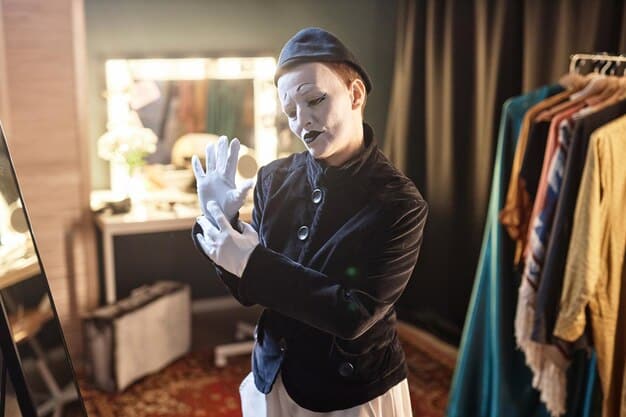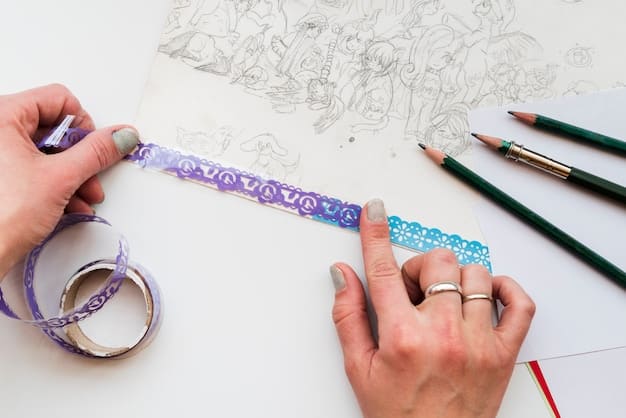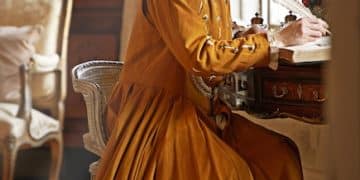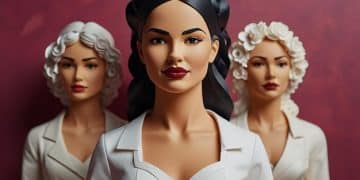Costume Designers: The Unsung Heroes of Film

Anúncios
Costume designers are the creative individuals responsible for crafting the visual identity of characters in film through clothing, contributing significantly to storytelling and often going unnoticed.
Anúncios
While actors and directors often receive the spotlight, the magic of cinema is also woven by those behind the scenes, most notably, the unsung heroes of film: celebrating the work of costume designers. These talented individuals craft the visual identity of characters through clothing, significantly contributing to the storytelling process.
The Art of Character Creation Through Costume
Costume design is a powerful storytelling tool. More than just clothing, costumes reflect a character’s personality, social status, and emotional state. A well-designed costume can make or break a performance, enhancing the actor’s portrayal and immersing the audience in the film’s world.
Anúncios
The Costume Designer’s Role
The costume designer works closely with the director and other production designers to create a cohesive visual world. They research the period, culture, and social context of the story. Then, they sketch designs, select fabrics, and oversee the construction of each garment.
Collaboration and Creativity
Successful costume design requires a strong collaborative spirit. The designer must communicate effectively with the actors, understanding their needs and preferences. They must also be resourceful and creative, finding innovative ways to bring their visions to life within the constraints of the budget and time.

Costume designers are responsible for telling a story without uttering a single line of dialogue. They are responsible for the look and feel of a show and must be able to interpret the story and guide the viewer’s eye.
- Reflecting personality and social status
- Enhancing the actor’s portrayal
- Immersing the audience in the film’s world
In essence, costume designers are visual storytellers whose creations breathe life into characters, weaving them seamlessly into the narrative fabric of the film.
Iconic Costumes and Their Impact
Certain costumes have become iconic, indelibly linked to the films in which they appeared. These costumes transcend the screen, becoming cultural symbols that continue to inspire and influence fashion and design.
Marilyn Monroe’s White Dress in “The Seven Year Itch”
This dress, designed by William Travilla, is one of the most recognizable costumes in film history. The image of Marilyn Monroe standing over a subway grate, her dress billowing in the air, is a defining moment in cinematic history.
Audrey Hepburn’s Little Black Dress in “Breakfast at Tiffany’s”
Designed by Hubert de Givenchy, this elegant dress epitomizes classic style and sophistication. This costume showcased the beauty of the actress and is seen as one of the most influential pieces of clothing.
Indiana Jones’ Signature Look
This costume, created by Deborah Nadoolman Landis, perfectly embodies the character. A brown leather bomber jacket, fedora, and a bullwhip are the defining elements of Indiana Jones signature look.
These iconic costumes demonstrate the power of costume design to create lasting impressions and contribute to the cultural significance of a film.
The Research Process: Diving into Details
Before even a single stitch is sewn, costume designers undertake a rigorous research process. This involves immersing themselves in the world of the story, studying historical periods, cultural nuances, and character backgrounds.
Historical Accuracy is Key
For period films, historical accuracy is crucial. Designers consult primary sources, such as paintings, photographs, and clothing from the era, to ensure that their costumes are authentic and believable.
Understanding the Character’s Background
Costume designers also delve into the character’s background, exploring their social class, occupation, and personal history. This information informs the choice of fabrics, colors, and styles, ensuring that the costume reflects the character’s identity.

Research is what separates a good costume from a great one. Diving deep into the historical, cultural, and personal context of the characters can unveil layers of depth.
The painstaking research process is essential for creating costumes that are not only visually stunning but also authentic and character-driven.
Challenges and Triumphs in Costume Design
Costume design is not without its challenges. Designers often face tight budgets, demanding schedules, and the need to create costumes that are both aesthetically pleasing and functional.
Budget Constraints
Limited budgets can be a major obstacle for costume designers. They must be resourceful and creative, finding ways to create stunning costumes without breaking the bank. This may involve repurposing vintage clothing, using inexpensive fabrics, or negotiating discounts with suppliers.
Time Pressures
Film productions often operate on tight schedules, leaving costume designers with limited time to create their designs. They must be highly organized and efficient, working closely with their team to meet deadlines.
Balancing Aesthetics and Functionality
Costumes must not only look good but also be functional. Actors need to be able to move comfortably in their costumes, perform stunts, and endure long hours on set. Designers must carefully consider the practical needs of the actors when creating their designs. The costume should enhance the actors performance and not hinder them.
- Repurposing vintage clothing
- Using inexpensive fabrics
- Negotiating discounts with suppliers
Despite these challenges, costume designers often achieve remarkable triumphs, creating costumes that are both visually stunning and strategically designed to support the film’s characters and setting.
Technology’s Impact on Costume Design
Technology is transforming the field of costume design, offering new tools and techniques that were once unimaginable. From computer-aided design (CAD) to 3D printing, technology is helping designers to create more complex and innovative costumes.
Computer-Aided Design (CAD)
CAD software allows designers to create detailed digital renderings of their designs, experimenting with different fabrics, colors, and styles. This helps them to visualize the final product and make adjustments before any fabric is cut.
3D Printing
3D printing is revolutionizing the creation of props and accessories for costumes. Designers can use 3D printers to create intricate masks, armor, and jewelry, pushing the boundaries of costume design.
With the digital age comes new and complex ways to create the desired look for the film’s characters. It may add more depth and texture to costumes that were not previously possible.
These are just a few examples of how technology is impacting costume design today. As technology continues to advance, we can expect even more exciting innovations in the field.
Recognizing Costume Design Excellence
While costume designers may not always receive the same recognition as actors or directors, their contributions are increasingly being acknowledged through awards and accolades. These awards not only celebrate excellence in costume design but also raise awareness of the importance of this craft.
The Academy Award for Best Costume Design
The Academy Award for Best Costume Design is the most prestigious award in the field. It is presented annually to the costume designer who has created the most outstanding costumes for a film. Receiving the Oscar is the most honorable recognition.
Other Awards and Recognition
Various other awards and nominations are given to costume designers each year. These awards help to elevate the visibility of the craft and honor the talented individuals who create the costumes we see on screen.
Elevating the art of costume design is becoming a priority for award shows. This opens more opportunity to show the appreciation for costume design that they deserve.
By recognizing and celebrating the work of costume designers, we can ensure that their contributions to the art of filmmaking are never overlooked.
| Key Point | Brief Description |
|---|---|
| 🎭 Character Creation | Costumes reflect character traits and social status. |
| 👗 Iconic Costumes | Memorable designs like Marilyn’s dress define film moments. |
| 📚 Research Depth | Designers study history and culture for authentic looks. |
| 🏆 Recognition | Awards elevate costume design’s importance in film. |
Frequently Asked Questions
▼
Costume designers are responsible for creating the outfits worn by characters in a film. They conceptualize designs, select fabrics, and ensure costumes align with the story and characters.
▼
The Costume designer affects the film greatly, creating character depth, establishing the mood, and providing visual interest in what the audience is watching. It is a major part of setting the tone.
▼
Budget constraints, tight deadlines, and creative clashes are all common challenges. The designer must always think outside the box to find clever and creative solutions.
▼
Absolutely, costume design requires effective communication with directors and other creative teams. All must be on the same page to ensure a unified vision, and to bring that vision to life.
▼
CAD and 3D printing streamlines the process, enabling designers to create intricate designs. These tools allow for accuracy and also more creativity overall.
Conclusion
In conclusion, costume designers are integral to the film industry. Their creativity shapes cinematic storytelling and has the ability to make or break a film entirely. They are definitely unsung heroes of film. Celebrating the work of costume designers is a must.





